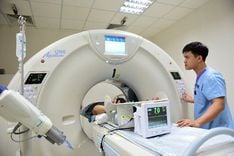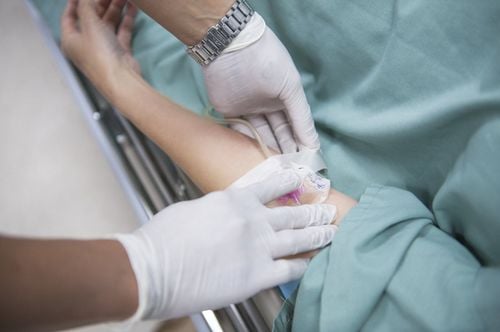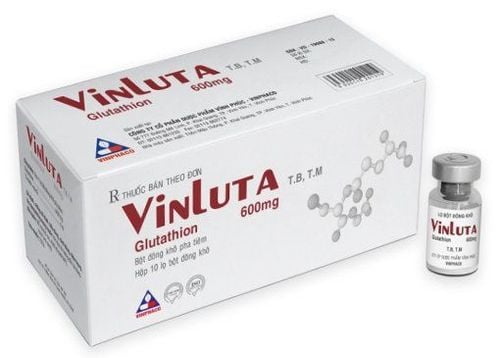This is an automatically translated article.
In the treatment of diseases in general and cancer in particular, the correct identification of lesions plays a decisive role in the outcome of treatment. PET/CT is one of the most accurate cancer detection techniques available today. When using simulated PET/CT images to plan accelerated radiotherapy, it is highly effective, especially when combined with dose-modulated radiotherapy techniques. This is a high technology of cancer treatment in the world today.
1.Dose-modulated radiation therapy using simulated PET/CT Scientific name: Dose-modulated radiation therapy using simulated PET/CT Common name: PET/CT scan Technical description: Combination of PET machine with CT machine created a system of PET/CT machines. The patient has both CT scan and PET scan in the same coordinate system. When combining PET/CT simulation with dose-modulated radiotherapy techniques, it will help to adjust the radiation beam according to the morphology and shape of the tumor, changing (increase/decrease) the radiation beam intensity according to the density of the tumor. cancer cell level (where there are more malignant cells will receive more radiation and vice versa).
2.What disease is this technique used for? Esophageal cancer Lung cancer 3.Indications and contraindications Indications:
Brain tumor Head and neck cancer Lung cancer Esophageal cancer Prostate cancer Soft tissue cancer Childhood cancer Alzheimer's Cerebral Palsy Epilepsy Dementia

Hình ảnh chụp PET-CT sau 6 tháng điều trị cho thấy khối u đã bị tiêu diệt hoàn toàn
4.Advantages and disadvantages of the technique Advantages:
CT images (clear and sharp anatomical structure images) are combined with PET images (functional and metabolic imaging at very early stages). early) will give very valuable information with high sensitivity, specificity and accuracy, far superior to many other diagnostic techniques. PET/CT is indicated to: help detect cancer early, classify cancer accurately, detect and evaluate recurrence, metastasis as well as evaluate the effectiveness of treatment methods and help in planning. radiation therapy with simulated PET/CT. When using simulated PET/CT images to plan accelerated radiotherapy, it is highly effective, especially when combined with dose-modulated radiotherapy techniques. This is a high technology of cancer treatment in the world today. Using simulated PET/CT, it will help to determine the biological target volume (BTV), which is an image of the tumor at the metabolic level, the cellular level, i.e. the entire volume of the metabolised cancer cells. including regions that have not seen structural changes were also detected. As a result, the radiation dose is most concentrated in the tumor, but low in the healthy tissue. The vital organs are optimally protected, so the treatment efficiency is high, with few side effects of radiation therapy. Improve the quality of life, prolong the survival time or increase the chance of cure for cancer patients. When simulating radiotherapy planning by PET/CT helps to accurately define the lesion margin in cases where the boundary is difficult to define between the tumor and surrounding tissues: co-dense tumors (dometrial cancer, laryngeal cancer, laryngeal cancer, etc.) esophageal, esophageal), between lung tumor and collapsed lung tissue... and at the same time determine the gross tumor volume (GTV), which helps in precise radiotherapy to the tumor tissue and avoids irradiation into healthy tissues. to improve effectiveness as well as reduce side effects caused by radiation. PET/CT detects small-sized tumors, detects regional lymph node metastases that are difficult to detect on CT. The use of PET/CT simulation for radiotherapy planning with accelerators (3D techniques and IMRT) will provide more accurate, effective and safe radiotherapy results with fewer side effects than using CT , MRI simulation. PET/CT helps to record myocardial perfusion and assess myocardial survival after intervention and after treatment Radiopharmaceuticals used for PET/CT imaging have a very short decay time (at most 110 minutes) and Radioactivity is very low, so PET/CT is safe. PET/CT can also be used for children. The rest of the radioactive drug will be eliminated from the body in the urine.

PET/CT giúp ghi hình tưới máu cơ tim và đánh giá sự sống còn của cơ tim sau can thiệp và sau điều trị
5.Implementation process Step 1:
Doctor examines, diagnoses disease Consultation and treatment Making fixed mask CT scan simulates radiation therapy Plans radiation therapy. Total therapeutic dose 60 - 66 Gy / 28 - 30 fractions. Check the plan Step 2:
Pre-treatment check digital X-ray: Take a digital check-up X-ray before each treatment (radiotherapy under image guidance). Compare the electronic portal image (EPI) of the patient before treatment with the digital reconstructed radiograph (DRR) image of the treatment plan to ensure the correct position. of the patient when the treatment was exactly as positional in the planning simulation with an allowable error of < 3 mm for head and neck tumors and < 5 mm for thoracic-abdomen-pelvic tumors. Radiation treatment: Radiation treatment for the patient. During the treatment, the technician will monitor the patient through the camera and the treatment parameters on the computer screen. The duration of each dose-modulated radiotherapy session under image guidance is 20-30 minutes. The total duration of the whole course of treatment is 6 -7 weeks..
6.Expression is normal after the technique. The patient will feel normal because there are no side effects. Do not restrict movement after shooting. Drink plenty of water a few hours after the scan.
7.When are the following manifestations of technique abnormal and need immediate re-examination? Anaphylaxis during and after the technique
8.Machine/equipment needed to perform this technique The most modern 128-row PET/CT system in Southeast Asia 9.Things to keep in mind when performing this technique perform this technique Avoid contact with children and pregnant women for 24 hours after radiation therapy. Before the PET/CT scan, the patient will be set up an intravenous line to inject radioactive drugs, no different from other conventional injections. You need to fast for 4-6 hours before the scan. The patient can drink plain water but no gum, soft drinks or anything with sugar. Rest and avoid vigorous physical activity, abstain from alcohol, coffee, and tobacco within 24 hours before the scan. Patients with diabetes who are taking oral medications should take their medication as directed by their specialist daily before coming in for the scan. If insulin is used, it must be injected at least 4-6 hours before FDG injection. Do not use Metformin 72 hours before and 24 hours after the scan.
Please dial HOTLINE for more information or register for an appointment HERE. Download MyVinmec app to make appointments faster and to manage your bookings easily.













